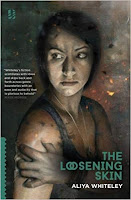“The funny thing is that getting the morning-after pill the first day of a zombie apocalypse is really no easier or harder than on a previously average day. No bigger a deal, the obstacles are just… different. More slow-moving, brain-eating hordes, sure, but fewer overtly religiose or obstructive pharmacists. The baseball bat I brought to use in case of the former was also effective on the triple-lock cabinets erected by the latter.” (p. 224)
This is a rich, intoxicating anthology of 19 short stories and musings. Several of the stories are set in the near future, such as the one in which the invention of new kinds of artificial dick leads, through one thing and another, to the collapse of capitalism. Other stories spiral backward — to the pogrom in York in 1190, to The Black Cap gay pub, to the narrator’s own history. There are ghost stories and ghostly stories, and a lot of it is strange and unsettling.
The last story, Dune Elegies, is one of several set in a bleak near-future, a world just beyond our current grasp. The narrator, “terfed off” their own radio show, takes up residence in a lighthouse near the stone mirrors at Denge and continues to transmit a podcast, but with a pervasive sense of lost connection. The narrator is unable to recall the names of Conrad Veidt and Derek Jarman while detailing their importance in queer history — we fill in the blanks as readers. Then there’s a response from listeners to the podcast, transmission of which triggers something in stones taken from the area, wherever they might be now. It’s such an odd, beguiling idea, the sort of story that sits with you long afterwards.
As well as what’s happening, there’s the way these stories are told, dense with allusion and word play, poetry and punning. There are references to films and TV shows, novels and academic texts — I’d have quite liked a bibliography and/or end notes for further reading. It’s not just that stuff is referenced; it is toyed with and spun. For example, one passage about the lives of particular pirates includes the phrase “our flag means life” (p. 229) reversing the title of the 2022-23 TV series while at the same time making a connection to its own exploration of sexuality and identity.
We frequently explore derivation and etymology, how meaning is constructed, generating history and identity. With that in mind, I think the cut-up technique of quotations and references may be a way of shaking things up to create new meanings and ideas. That took me back into my own past when, as a university student some three decades ago, I got hooked on linguistic relativity and the so-called “Sapir-Whorf hypothesis” that language shapes or even determines our thoughts and perceptions.
(In fact, it’s an axiom, not a hypothesis, and not one put forward by the linguists Sapir and Whorf as such, who never wrote together. But perhaps that makes it more fitting as a label, evidence that we need a name, any name, to be able to remonstrate with an idea.)
It’s not just about words in the stories here: in dreams of being Joan of Arc and her insistence on wearing trousers, or in detailing why Artemis wore a short skirt, we’re exploring the construction of gendered and non-gendered identities.
By chance, I was reading this as I saw the new documentary From Roger Moore With Love, which details how movie-star “Roger Moore” was an invented persona; Moore learned to play this persona and then, from The Spy Who Loved Me, applied that to his role as James Bond. At one point, Moore’s friend Christopher Walken says this shouldn’t be a surprise because we’re all self-invented people — there’s a point in our lives, perhaps more than one, where we choose who we are. How fascinating to see archive interviews with Moore uncomfortable with the violence and misogyny of Bond or — in an episode of Hardtalk which so yielded something new from its subjects — voicing concern about the “heroic” image of his Bond wielding a gun. I’m not sure I’d have picked up on that if I’d not been reading this book…
Like the world of James Bond, the stories in this book are frequently lusty, even graphic. But Bond is about gratified desire, sex just part of the mix with exotic locations, stylish clothes, fancy food and gadgets. In the book, desire is, I think, less external but bubbling up from within. There’s a lot here on the bloody, visceral heft of bodies — of ourselves not just as contracted identities but as physical things.
“What it means to be in a body, differently, is what the Crusades take aim against,” (p. 61).
So much of this book is exploring that haunting idea, the half of the sentence before “is” and the sentence as a whole.
You can buy Truth & Dare by So Mayer direct from Cipher Press.























